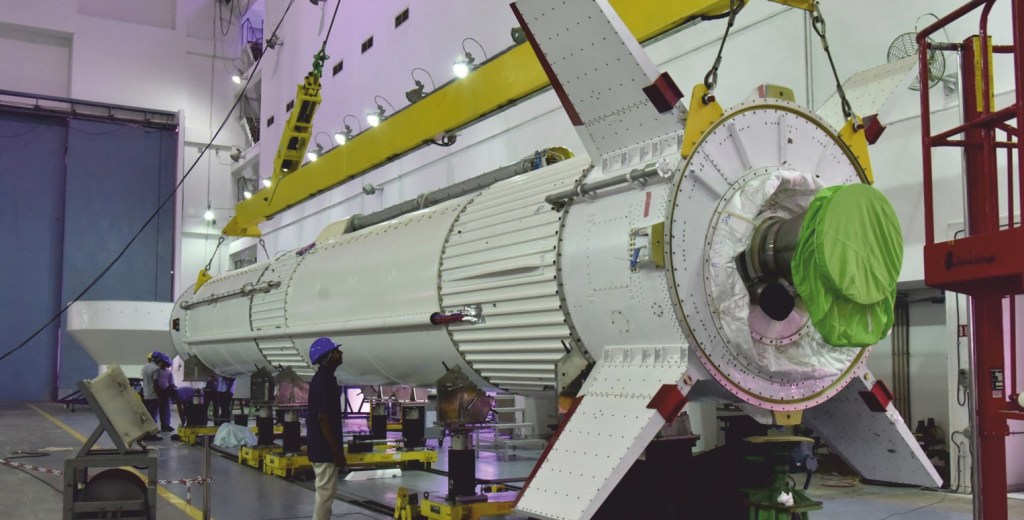Featured image credit: ISRO
Liftoff Time | October 21, 2023 – 4:30 UTC | 10:00 IST |
|---|---|
Mission Name | Gaganyaan’s In-Flight Abort Demonstration of Crew Escape System (CES) |
Launch Provider | Indian Space Research Organization (ISRO) |
Customer | Indian Space Research Organization (ISRO) |
Rocket | TV-D1 |
Launch Location | First Launch Pad (FLP) located at the Satish Dhawan Space Centre, on the Sriharikota island, India |
Payload mass | ~23,000 kg (~51,000 lb) |
Where was the spacecraft going? | Maximum altitude of 16.9 km (~10.5 mi); then, splash down, and recovery |
Did they be attempt to recover the first stage? | No, they were not recovering the first stage |
Where did the first stage land? | It crashed into the water at ~6.0 km (~3.5 mi) downrange |
Did they attempt to recover the fairings? | No, they were not recovering them |
Were these fairings new? | Yes |
This was the: | – 1st in-flight abort test in the Gaganyaan program – 2nd abort test in the Gaganyaan program |
Where to watch | Official replay |
What’s All This Mean?
ISRO launches a test vehicle, the TV-D1, for the Gaganyaan program, to perform an in-flight abort demo. Therefore, the rocket carries a Crew Module (CM) featuring a Crew Escape System (CES) — basically, an escape tower. Liftoff takes place from the FLP, at the Satish Dhawan Space Center, with the CM separating afterward. Subsequently, the escape system pulls the module away from the vehicle. Finally, all three major components fall into the waters, with the CM being the only one expecting to be recovered.
How Did It Go?
After a couple of delays due to weather, there was a launch attempt at 3:15 UTC. However, at T-5 seconds a computer detected an anomaly during engine ignition. This automatically suspended the demonstration, only for ISRO to come back later with the announcement of a new T0 time of 4:30 UTC, when the rocket finally blasted off the pad. The flight proceeded normally, with the crew escape system igniting the high-altitude escape motors and performing as expected.
The grid fins were extended for stability, and the crew module subsequently freed itself. The drogue parachutes came into action first, considerably reducing the module’s velocity. Later, the main chutes continued the task, and allowed the vessel to softly splash down off the coast of the island. Recovery operations proceeded nominally with the assistance of the Indian Navy. Gaganyaan’s crew module will be returned to ISRO’s facilities.
It is worth mentioning that the module floated upside down before recovery, as no flotation devices were present. Once those are installed, they will ensure the capsule remains in the right position with the crew on board.
What Is The Gaganyaan In-Flight Abort Demo?
This mission’s purpose is a test of the Gaganyaan In-Flight Abort Demonstration (IFAD) of Crew Escape System (CES). Consequently, its main goal is to assess how this system would perform in operational conditions. Additionally, a series of other objectives include testing the flight vehicle itself, and various of its components. Separation systems and deceleration hardware are also subject study of this mission. Presently, this abort demo represents the first in a set of tests in preparation for a crewed flight. A pad abort test (PAT) took place in 2018, but with the capsule’s design having considerably changed, it will have to be repeated.
Development of the Gaganyaan spacecraft requires the agency to consider many design constraints. These aim at ensuring not only the well functioning of the vessel, but also the safety of the people traveling inside it — vyomanauts, or Indian astronauts. The spacecraft will provide room for three of them, and will eventually feature rendezvous and docking capabilities. However, the one flying on this demo flight is far from being a final product.
Crew Module For The In-flight Abort Demo
At the present time, the module consists only of an unpressurized capsule with its structure made out of aluminum. Its truncated conical shape displays a maximum diameter of 3.1 m (~10 ft) and a height of 2.97 m (~9.70 ft), while massing at 4,520 kg (~9,900 lb). Implementation of cork layers enables them to simulate a thermal protection system. This test item’s avionics stem from heritage equipment implemented on ISRO’s previously developed launch vehicles. On the other hand, it makes use of a Mini Advanced inertial navigation system (INS) for that purpose. The latter system sees support through augmentation by GPS and its Indian equivalent: NavIC.
Moreover, the CM hosts many separation systems, which will be part of the testing. For instance, there is such an interface connecting to the service module (SM), right under the first one. Another separation system frees the CES from the crew module, and yet another one, the CM from its fairings (CMF). Finally, for the parachutes to deploy, the apex cover needs removal. Each of them went through their own individual certification tests.
A total of 10 parachutes find themselves in the upper portion of the vessel, just under the apex cover. Pyrotechnical systems trigger their deployment, in order to achieve deceleration. The CM should splash down onto the water at 8.5 m/s (~28 ft/s), where it should float. Sea markers and location transmitters will aid the recovery teams in finding the spacecraft.
Gaganyaan’s Crew Escape System
Comprising five solid rocket motors, this system is in charge of “ejecting” the crew from a malfunctioning launch vehicle. Of course, it pulls the whole capsule together with its inhabitants, instead of them jumping individually off of it, and takes it to safety. The hardware usually receives the name of “escape tower,” the reason why becoming evident by giving it a glance. In any case, these towers are fairly common use, and saw use in the iconic Apollo flights. Further crew-rated spacecraft featuring them include Orion (SLS), Shenzhou, and Soyuz.
If you want to know more about launch escape systems, you can read our article on abort towers, and watch its associated video.
Particularly, Gaganyaan’s CES measures 15.5 m (~51 ft) in height, from the tip of its nose to the lowest rim of the CMF. Its maximum diameter is 4.05 m (~13.3 ft), while the most slender part of the tower itself features a diameter of about 0.8 m (~2.5 ft). Assuming it showcases the reported inert mass of 12,500 kg (~27,600 lb), and the propellant masses listed in the table below, then the whole CES should mass at about 18,000 kg (~39,700 lb).
Subcomponents’ Description
From top to bottom, the uppermost motors are the low-altitude and high-altitude pitch ones (LPM and HPM, respectively). These reside almost at the fore end of the tower in order to benefit from the lever arm for maneuvering. In a slightly lower position, the CES jettisoning motor (CJM) comes into action if, during a launch, there was no need of the CES. In that case, the escape system separates, saving mass. The next one is the low-altitude escape motor (LEM), which would fire upward except for the nozzles redirecting the combustion gases. They specifically point in such a way as to avoid those scorching jets impinging the CM.
Right below there is an avionics deck protected from the relative wind by a conical shroud. They connect to a bell-shaped shroud allowing the high-altitude escape motors (HEM) to correctly point their nozzles downward, but also outward. Inside this shroud a conical structure transfers all thrust forces to the crew module fairing (CMF). There is also an attachment between the bell-shaped shroud and the CMF. The latter showcase four grid fins for stabilization after mission abort. Finally, inside the fairing lies the CM.
Motors’ Comparison
| Qty. | Nozzles per motor | Propellant mass [kg] | Propellant mass [lb] | Max vacuum thrust [kN] | Max vacuum thrust [lbf] | |
|---|---|---|---|---|---|---|
| CJM | 1 | 4 | 2,098 | 4,630 | 875.1 | 196,730 |
| LEM | 1 | 4 | 2,098 | 4,630 | 875.1 | 196,730 |
| HEM | 4 | 1 | 271 | 600 | 260.7 | 58,610 |
Test Flight And Abort Demo
| Events | Flight time [s] | Altitude [km] | Relative velocity [m/s] |
|---|---|---|---|
| Ignition | -6.0 | 0.0 | 0.0 |
| Liftoff | 0.0 | 0.0 | 0.0 |
| TV-CES separation | 60.6 | 11.7 | 363.0 |
| CM-CES separation | 90.6 | 16.7 | 147.0 |
| Mortar Ign. for ACS Parachute deployment | 95.9 | 16.6 | 148.7 |
| Apex Cover Separation | 96.2 | 16.6 | 149.3 |
| Mortar Ign. for Drogue Parachute deployment | 98.2 | 16.5 | 152.0 |
| Drogue Parachute release | 296.1 | 2.4 | 62.8 |
| Mortar Ign. for Pilot Parachute Deployment | 296.3 | 2.4 | 64.1 |
| Main Parachute Deployment | 296.5 | 2.4 | 64.1 |
| CM Touchdown | 531.8 | 0.0 | 8.5 |
What Is The TV-D1?
A single stage rocket came into existence to support the testing needs for the crewed program: the TV-D1. This designation is actually an abbreviation of “test vehicle” — referring to the launcher — and “demonstration 1” — specifically identifying the test. Its design derives from that of the L40 stages, or liquid side boosters, strapped to the Geosynchronous Satellite Launch Vehicle (GSLV). Nevertheless, given that the TV possesses flight systems of its own, changes to its body and aerodynamic surfaces, and a modified power plant, it is reasonable to say that this is a new rocket.
The TV-D1 is 19.5 m (~64 ft) long, while it features a diameter of 2.1 m (~7 ft). This is considered from the top of the CM-CES adapter, to the bottom of the modified Vikas engine’s nozzle. The latter powers the vehicle, running on hypergolics: di-nitrogen tetroxide (N2O4) as oxidizer, and UH-25 as fuel. UH stands for unsymmetrical hydrazine, with 25 indicating a composition of 25 % hydrazine hydrate and 75 % unsymmetrical dimethylhydrazine (UDMH). At liftoff, the TV-D1 should mass at approximately 26,000 kg (~57,300 lb), broken down as follows:
- Inert mass: 7,000 kg (~15,400 lb)
- N2O4 mass: 12,000 kg (~26,500 lb)
- UH-25 mass: 7,000 kg (~15,400 lb)
Each propellant tank presents an upper and a lower dome, with an intertank structure attaching them together. The lower position is for the oxidizer, while the fuel is stored inside the upper tank. At the base of the launch vehicle, a bay houses the Vikas, as well as serves as an anchoring point for four fins. At its top, the equipment bay allows for the installation of avionics and other components.












This is the most comprehensive guide to the recent TV-D1 test mission done by ISRO. Well done !!
Hello Atif! Thank you for your kind words I’m glad you enjoyed the article. It’s really exciting to see how another crewed program progresses. I can’t wait to see them sending humans to space!
Hope to see you around again!
Absolutely, ISRO is really working hard from last couple of decades, working on cryogenic engines, launch vehicles and satellites and that too in very low budget.
The Gaganyaan program is by far the most exciting mission ISRO has realised. Just like you, I can’t really wait ISRO send humans into space. Let us hope for the best and see how it turns out ! Thanks